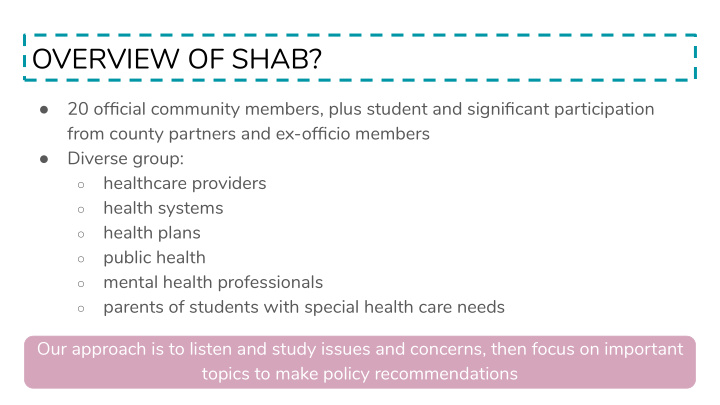



OVERVIEW OF SHAB? 20 official community members, plus student and significant participation ● from county partners and ex-officio members Diverse group: ● healthcare providers ○ health systems ○ health plans ○ public health ○ mental health professionals ○ parents of students with special health care needs ○ Our approach is to listen and study issues and concerns, then focus on important topics to make policy recommendations
The following slides detail POLICY recommendations were voted on January 27th by the Chesterfield RECOMMENDATIONS SHAB. 2019 - 2020
WELLNESS INTEGRATION IN PRACTICE Research shows that physical activity improves academic performance
WELLNESS INTEGRATION Overview Wellness integrators train teachers how to use movement and physical ● activity in elementary school classrooms Infuses a culture of health and wellness ○ Background SHAB’s past recommendation was to have one wellness integrator per ● magisterial district We currently have 3 ● Recommendation Continue the Wellness Integration program ● Fund 2 additional wellness integrators for elementary schools ● This will fulfill the goal of one per magisterial district ○ Budget Implication $123,368 ● $61,684 per position ○
SCHOOL NURSES Overview School nurses are critical to a healthy school environment ● There should be a full-time Registered Nurse (RN) in every building ● Background CCPS does not meet best practice standards for professional staffing to ● student ratios Currently 52 school nurses ● Recommendation Hire an additional 18 school nurses ● Total: 70 school nurses ○ Allows for a school nurse in every school building and each special ○ education clinic Cost $1.45 million ● $80,572 per position ○
EQUITY CONSIDERATION RECOMMENDATIONS Be guided by commitment to health equity in decision making ● Prioritize where to place positions and how to focus their efforts based on ● student populations with the greatest needs and barriers to good health. Specifically: Number and Title I status Free/reduced lunch percentage of children with chronic health conditions Size of ESL & Racial and ethnic Academic Exceptional Education composition performance populations
OTHER CURRENT ISSUES Social School Active Substance Staffing Emotional Nutrition Recess abuse Learning prevention ● Amount of time ● Amount of ● Punishment vs. ● Social workers ● Programming for lunch recess Health Education ● Psychologists ● Standards ● Processed foods ● Ensuring it’s not ● Etc. ● Sugar content taken away as a ● Allergies punishment
Recommend
More recommend